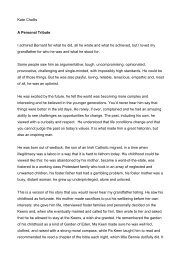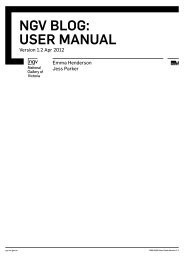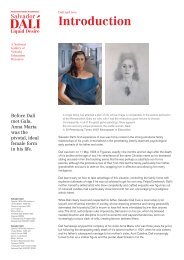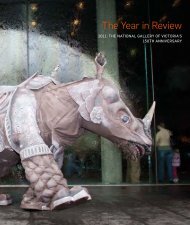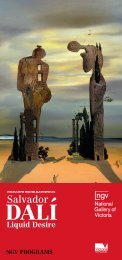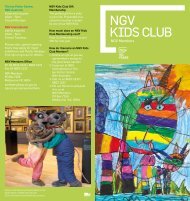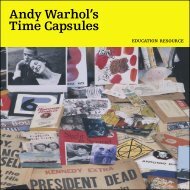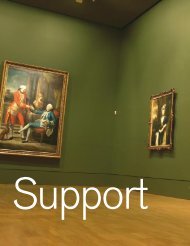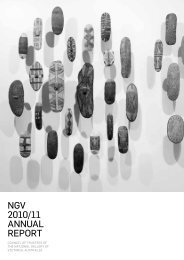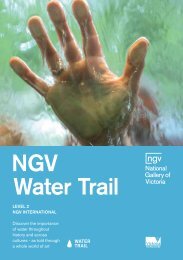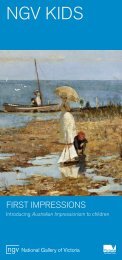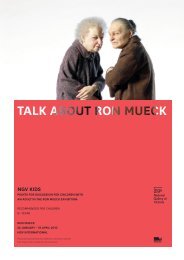EDUCATION RESOURCE - National Gallery of Victoria
EDUCATION RESOURCE - National Gallery of Victoria
EDUCATION RESOURCE - National Gallery of Victoria
You also want an ePaper? Increase the reach of your titles
YUMPU automatically turns print PDFs into web optimized ePapers that Google loves.
Animal Interpretations<br />
Biographical reference<br />
Dick Pantimas Tjupurrula was born at Yippa, north <strong>of</strong><br />
Sandy Blight Junction, near the Northern Territory and<br />
Western Australia border. He was identified as the twoyear-old<br />
infant ‘Pandimatu’ by Norman Tindale at Mt<br />
Liebig in 1932. He was the younger brother <strong>of</strong> great<br />
Papunya Tula artist Johnny Warangkula Tjupurrula<br />
(c.1925–2001), with whom he shared the Kalimpinpa<br />
water story and other Dreamings. He came with his family<br />
to Hermannsburg mission before the Second World War<br />
and he was recorded as a stockman at Haasts Bluff in<br />
1957.<br />
Dick Pantimas Tjupurrula later moved to Papunya and<br />
was one <strong>of</strong> the original shareholders <strong>of</strong> Papunya Tula<br />
Artists. He began to paint in earnest for Andrew Crocker<br />
in 1980, working mainly on small-scale canvases. Many<br />
<strong>of</strong> his works depicted the Kalimpinpa water story, also his<br />
Dreaming. Tjupurrula died in 1983, before his career had<br />
time to blossom.<br />
Materials and techniques<br />
A modern art movement began at Papunya in central<br />
Australia in 1971, when Aboriginal men from the Western<br />
Desert were first encouraged to paint their stories with<br />
new materials. Ge<strong>of</strong>frey Bardon, a school teacher at<br />
Papunya community school, asked his students to paint<br />
a mural on the school walls, using ceremonial body and<br />
sand designs. Eventually a number <strong>of</strong> senior men came<br />
together to create a historic mural depicting the Honey<br />
Ant Dreaming associated with the Papunya community.<br />
The mural, a proud symbol <strong>of</strong> Aboriginal culture, inspired<br />
other senior men to start painting. They took discarded<br />
materials from the settlement – fruit box ends, floor tiles,<br />
scraps <strong>of</strong> board – and unlocked ancient designs that until<br />
1971 had been kept hidden from the uninitiated. The<br />
following year, the founding artists, keen to sell their work,<br />
formed their own company. Papunya Tula Artists Pty Ltd<br />
has operated successfully as an independent business<br />
ever since. Papunya Tula artists have transformed the way<br />
we see the land and the history <strong>of</strong> art in this country. Due<br />
to the ‘big bang’ effect <strong>of</strong> the Papunya Tula movement,<br />
Aboriginal art, in all its diverse forms, has become the<br />
mainstream <strong>of</strong> Australian contemporary art practice and<br />
has leapt onto the international stage.<br />
Issues for discussion<br />
• Contrary to common perception,<br />
Aboriginal art is dynamic and has<br />
never been static. The complex<br />
meanings in Aboriginal art and its<br />
many different styles provide an<br />
opportunity to learn more about<br />
Aboriginal culture. Compare other<br />
diverse Aboriginal styles through the<br />
exhibition The <strong>Gallery</strong> Ark<br />
Symbolism<br />
Throughout the Western Desert,<br />
ancestral beings emerged from<br />
the body <strong>of</strong> the land and travelled<br />
extensively. During their epic<br />
Dreaming journeys, ancestral beings<br />
created sources <strong>of</strong> water and other<br />
natural features, established laws for<br />
Aboriginal people to follow, and then<br />
entered into and became the land,<br />
leaving their spiritual power in the<br />
landscape.<br />
In Serpent Dreaming at Yippa 1983<br />
the artist depicts the creation story<br />
<strong>of</strong> his birthplace, Yippa, a small salt<br />
lake. Two great serpents came to<br />
Yippa from the east and began to<br />
fight. So fierce was their battle that<br />
it excavated the lake bed. One <strong>of</strong> the<br />
snakes was overpowered and it can<br />
be seen to this day in the form <strong>of</strong> a<br />
long, low and rocky hill: its head is a<br />
jutting rock. The other snake carried<br />
on westwards. In this painting the<br />
lake is shown with the snake and the<br />
abundant vegetation associated with<br />
water. The dark patches around the<br />
salt lake represent claypans.<br />
Compare and contrast<br />
Find another work in The <strong>Gallery</strong> Ark<br />
that represents a snake.<br />
Did you know?<br />
The name Papunya Tula is derived<br />
from tula, a small hill near Papunya,<br />
which is a Honey Ant Dreaming site.<br />
Dick Pantimas<br />
Tjupurrula<br />
Luritja c.1930–1983<br />
Serpent Dreaming at<br />
Yippa 1980<br />
synthetic polymer paint<br />
on canvas<br />
60.8 x 51.0 cm<br />
Purchased from<br />
Admission Funds, 1988<br />
© Estate <strong>of</strong> the artist,<br />
courtesy <strong>of</strong> Aboriginal<br />
Artists Agency, Sydney<br />
12 THE GALLERY ARK <strong>EDUCATION</strong> <strong>RESOURCE</strong> 13



